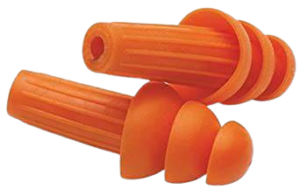Protecting our ears is super-important when we have tinnitus. So here is a rundown of the kind of protection that’s available and, importantly, how to wear them correctly to get the hearing protection you want.
Let’s start at the beginning…
Why wear hearing protection?
The proper use of hearing protection:
- prevents hearing damage and safeguards our ability to enjoy sounds in the future
- prevents our tinnitus from becoming more intrusive (because of additional noise-related hearing loss or tinnitus)
- enables us to enjoy (and, if necessary, endure) a noisy environment in our everyday life
What kind should we use?
What hearing protection we need depends on the environment, situation (e.g. whether we want to be able to hear other people), noise type and noise level.
Foam earplugs
Foam earplugs are the most common earplugs used. We tend to grab a pair when we’re doing some noisy DIY or attending a music gig or a noisy sporting event. They don’t need special fitting, and you can find them on the shelves in supermarkets or chemists.
 How to insert them correctly
How to insert them correctly
- Roll and squeeze the entire earplug so that it’s small enough to slide into your ear canal.
- Reach over your head with the hand opposite to the ear in which you’re inserting your foam earplug. Pull up and back on the top of your ear to straighten the ear canal.
- Use your other hand to slide the compressed earplug into your canal gently and slowly until it is as deep as is comfortable. Then let go of your ear. Depending on your hearing level you should hear and feel the foam earplug expand to fill your ear.
Triple flange earplugs
The “flanges” in these earplugs are the 3 tiers of rubbery material you can see below (that make the earplug look like a Christmas tree). These are designed to create a seal against your ear canal.

These are available either as they are, or with changeable filters like these:
The earplugs without filters are helpful if you want to manage a consistent noise level, for example if you work in a continually noisy environment. They are available with different levels of noise reduction. If you are serious about protecting your hearing it’s worth checking what level of decibels you will be exposed to and making sure the pair you buy will protect you from that. You will find that information on a datasheet which will be either on the website you buy them from or via a link to the manufacturer’s website. Brands you may be familiar with include 3M and Howard Leight (Honeywell).
The ones with filters are a great way of ensuring you always have ear protection available for different environments that you will encounter. As I LOVE music, I use music earplugs from a company called EarPeace. Mine come with three changeable filters like the image above – medium, high and max protection. Not only do I use mine at the many music gigs I attend, I carry them around with me everywhere so I can pop them in if I suddenly find myself in a noisy environment. The beauty of having changeable filters is you can quickly change them to suit what you’re doing. For example, when you go to festivals you might want to wear the max protection while you’re watching a band, but reduce the protection while you’re wandering around with friends or buying food.
How to insert them correctly
- Reach over your head with the hand opposite the ear in which you’re inserting your earplug. Pull up and back on the top of your ear to straighten the ear canal.
- With your other hand grasp the stem of the earplug and insert into your canal gently and slowly until it the flange nearest the stem is snug against the opening of your ear canal. Then let go of your ear.
- Tug on the stem of the earplug to feel a good airtight seal between your ear canal and the earplug.
- To remove them use a gentle, slow twisting motion to break the airtight seal.
Ear Defenders
Also known as earmuffs or noise muffs, ear defenders fit snugly over your head and your ears to create an airtight seal. Because they need to be close-fitting, it can take a while to get used to the sensation, but if the headband tension isn’t tight enough, the sound protection decreases. The ear cups need to cover your ears entirely to create that airtight seal. Again, if the ear cups are too big or too small they might not give you the hearing protection you need. These are super easy to use as you can easily put them on and remove them. They’re not so handy to carry around in your handbag or pocket though, for unexpectedly noisy environments!
Tinnitus and hearing protection
There are a couple of things to be aware of when you have tinnitus and use hearing protection:
It’s possible you will notice your tinnitus more while you’re wearing ear plugs or ear defenders. It all depends on the environment you’re in and the level of noise reduction you have chosen. As with many aspects of living with tinnitus it’s a balancing act – between protecting your hearing and preventing your tinnitus from getting worse on the one hand, and not placing yourself in a position where all you are aware of is the noise in your head.
When you remove your hearing protection you may find your environment a bit overwhelming, and your tinnitus may react to that noise. So, if you have a choice, I recommend you wait to do so until you’re in a fairly neutral or normal environment.



